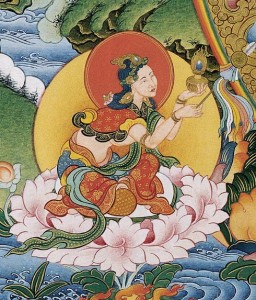
The following is an excerpt from a teaching by Jetsunma Ahkon Lhamo called “Mindfulness of Cyclic Existence”
The subject of this teaching is the difficulty that Westerners have in coming to grips with some of the concepts that are foundational to Buddhism. They are so foundational as to be almost invisible at times. Yet the concepts are difficult for us because we have our own concepts and philosophies that argue against these that are also so foundational that they are practically invisible. They are so much a part of the fabric of our perception and our thinking that we often don’t realize these thoughts are affecting us deeply.
What happens is that when we try to get a grip on Buddhist philosophy, or when we try to become mindful in a constant way, we find that there is difficulty. We may not understand what that difficulty is, or we may find that even without our knowing we have a very superficial understanding of Buddhist concepts, or we may find that we feel there is some superficiality about our approach to the path. Yet we can’t seem to get a grip on it. We can’t seem to understand what it is that is bothering us.
I think that this particular subject is not only of importance to Buddhists, or to those that are even thinking about becoming Buddhists, or even to those that are peripherally Buddhists, but I also think it’s a subject that bears recognition by anyone who does any meditation of any kind.
In Buddhist philosophy, a tremendous amount of thought and energy goes into making one understand how to stabilize the mind. In fact, if you could boil down Buddhist philosophy, and even Buddhist practice, the underlying goal would be how to stabilize the mind. It’s a difficult concept to understand because we as Westerners and Americans have our particular idea of what stabilizing the mind must be like. In one way, we could understand stabilizing the mind by understanding the opposite. We think of a person who is unstable as being mentally deranged or something like that. We don’t realize that most ordinary people, according to Buddhist thought, have unstable minds. We don’t realize that this is actually one of the symptoms or conditions that is prevalent in what Buddhists call samsara, or cyclic existence. But in fact this is true, and we must learn to recognize the lack of stability in our own minds.
One of the first ways in which that lack of stability is addressed is by addressing the attachment or the attraction that we have, or even the grasping that we have, toward hope and fear. This is something that you hear about again and again and again in the Buddha’s teaching: how attached we are to hope and fear, how difficult hope and fear are, and how these things lead to an unstable mind. It’s very hard for Westerners to understand. I would like to describe some of the Buddhist thought on the attachment to hope and fear, but more I would like to concentrate on why it is that Westerners have such a difficult time with this concept. If we can understand why we have such a difficult time with it, we may understand that in one way we have never really isolated the ideas of hope and fear, put them out in front of us so that we can really examine how much a part of the fabric of our minds these concepts are.
As a Westerner, there is actually an underlying – and even, I think, overt attitude – that is considered to be admirable or noble. We certainly have our particular norms, our own particular standards, our own particular attitudes that are unique to the Western world and specifically unique to Americans. Without going to the trouble of isolating all of them, I’d like to say that we have a certain picture or image that we’ve grown up with. Of course, it changes from generation to generation, but until very recently not that much. Still, there are some threads that continue generation to generation. We have our own particular image, our own particular ideal. What usually happens is if we grow up with an image or an ideal, it becomes so much a part of us, so ingrained, so woven into our particular emotional and mental and philosophical tapestry, that we don’t notice it, in the same way that you might look at a woven blanket and see a certain array of colors within the blanket. You really wouldn’t pick out the pink in there or the blue, or really isolate them in that way. In the same way, we have attitudes that are woven in. They are part of our structure. Therefore, they are never pulled out. The thread is never pulled out, never really isolated. Hope and fear certainly are in there, and our particular attitude toward hope and fear, as a Westerner, should be examined. When looked at next to the Buddhist ideas about hope and fear, we might come to some shocking awareness.
Copyright © Jetsunma Ahkon Lhamo. All rights reserved






